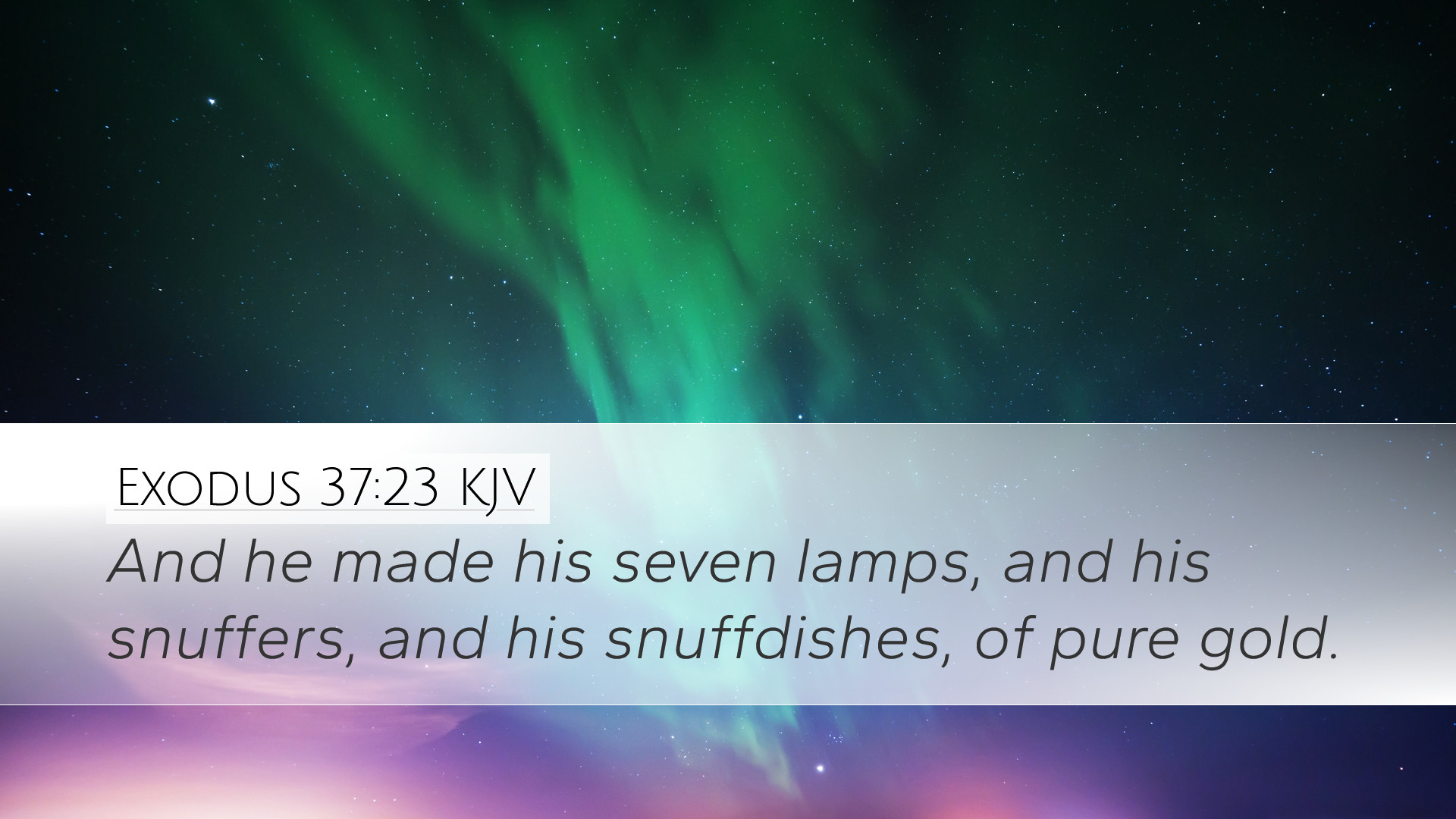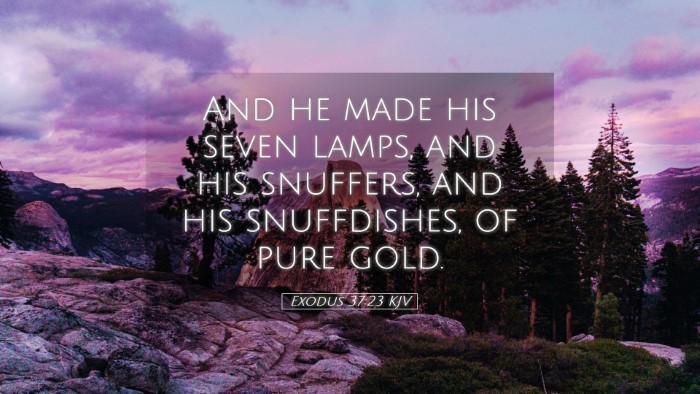Commentary on Exodus 37:23
Exodus 37:23 states: "And he made his seven lamps, and his snuffers, and his snuff dishes, of pure gold." This verse, while seemingly straightforward, highlights the intricate details involved in the construction of the candlestick (menorah) for the Tabernacle, emphasizing both its function and significance in the worship of God.
Introduction
The candlestick, a central piece of the Tabernacle furnishings, serves not only a practical purpose but also a symbolic one. The act of making seven lamps signifies completeness, illuminating the idea of God’s presence among His people through light. Commentaries by Matthew Henry, Albert Barnes, and Adam Clarke provide insights that enhance our understanding of this verse.
Insights from Public Domain Commentaries
Matthew Henry’s Commentary
Matthew Henry emphasizes the significance of the seven lamps. He notes that the number seven often symbolizes perfection and fullness in Scripture. The lamps represent the light of God’s truth and guidance provided to His people. He also highlights the craftsmanship involved, indicating that every detail was crafted with care, underscoring the reverence due to sacred objects.
- The Symbolism of Light: Light in biblical texts often symbolizes divine presence and wisdom. The seven lamps can be seen as representative of the complete illumination that God brings into the life of His followers.
- Significance of Gold: The use of pure gold not only signifies purity and value but also the majesty of God's presence among His people. It speaks to the worthiness of God’s dwelling place.
- Spiritual Application: The lamps can be viewed as a metaphor for the Church—the body of Christ—being the light of the world. Just as the lamps required oil to burn, believers need the Holy Spirit to shine their light effectively.
Albert Barnes’ Notes
Albert Barnes provides additional context by discussing the practical aspects of the lamps. He notes their importance in the daily functioning of the Tabernacle and the continuous burning that was required, which symbolizes the ongoing worship and service to God. Barnes also reflects on the practical necessity of light in the purpose of worship.
- Functional Importance: The lamps were crucial for illuminating the sacred space of the Tabernacle, reflecting the need for divine light in worship and service.
- Continuous Worship: The reference to snuffers and dishes indicates that careful maintenance was part of worship. Just as the lamps needed tending, so too does the spiritual life require attention.
- Christological Perspective: In a more extensive interpretation, the light of the lamps can foreshadow Christ as the Light of the World, illuminating the path for humanity.
Adam Clarke’s Commentary
Adam Clarke offers a detailed analysis of the construction materials and the methodology behind the making of the lamps. He also explores the theological implications of the candlestick as a whole. Clarke interprets the candlestick as a foreshadowing of heavenly truths.
- Materials and Craftsmanship: The candlestick's design illustrates God’s concern for beauty and order in worship. Clarke points out that no material was spared in making this sacred object.
- Foreshadowing and Typology: Clarke often emphasizes typology in the Old Testament. He views the candlestick as symbolic of the Church and its existence as a light amidst darkness.
- Connection to Worship: The necessity of the snuffers and dishes points to the continuous effort required to maintain a vibrant relationship with God through worship. This maintenance reflects on the believer’s duty to keep their spiritual lives in order.
Theological Implications
As we delve deeper into the implications of Exodus 37:23, we can consider several theological themes that emerge from the construction of the candlestick:
- Divine Presence: The establishment of the lamps signifies that God desires to dwell among His people. The very act of making such a sacred object encourages us to consider how we create space for God in our lives.
- Illumination of Truth: The candlestick serves as a reminder of the wisdom and truth that God provides. It challenges believers to seek His light and reflect it to others.
- Commitment to Worship: The maintenance involved in keeping the lamps lit introduces the idea of dedication in worship, urging believers to be diligent and committed to their relationship with God.
Conclusion
Exodus 37:23 encapsulates critical elements of worship, symbolism, and divine craftsmanship. The insights from Matthew Henry, Albert Barnes, and Adam Clarke illustrate the importance of this verse in understanding the Tabernacle's role in Old Testament worship and its continued relevance to modern believers.
As pastors, students, and scholars reflect on this verse, may it inspire a deeper commitment to uphold the light of Christ in their lives and communities, fostering continuous worship and devotion.


